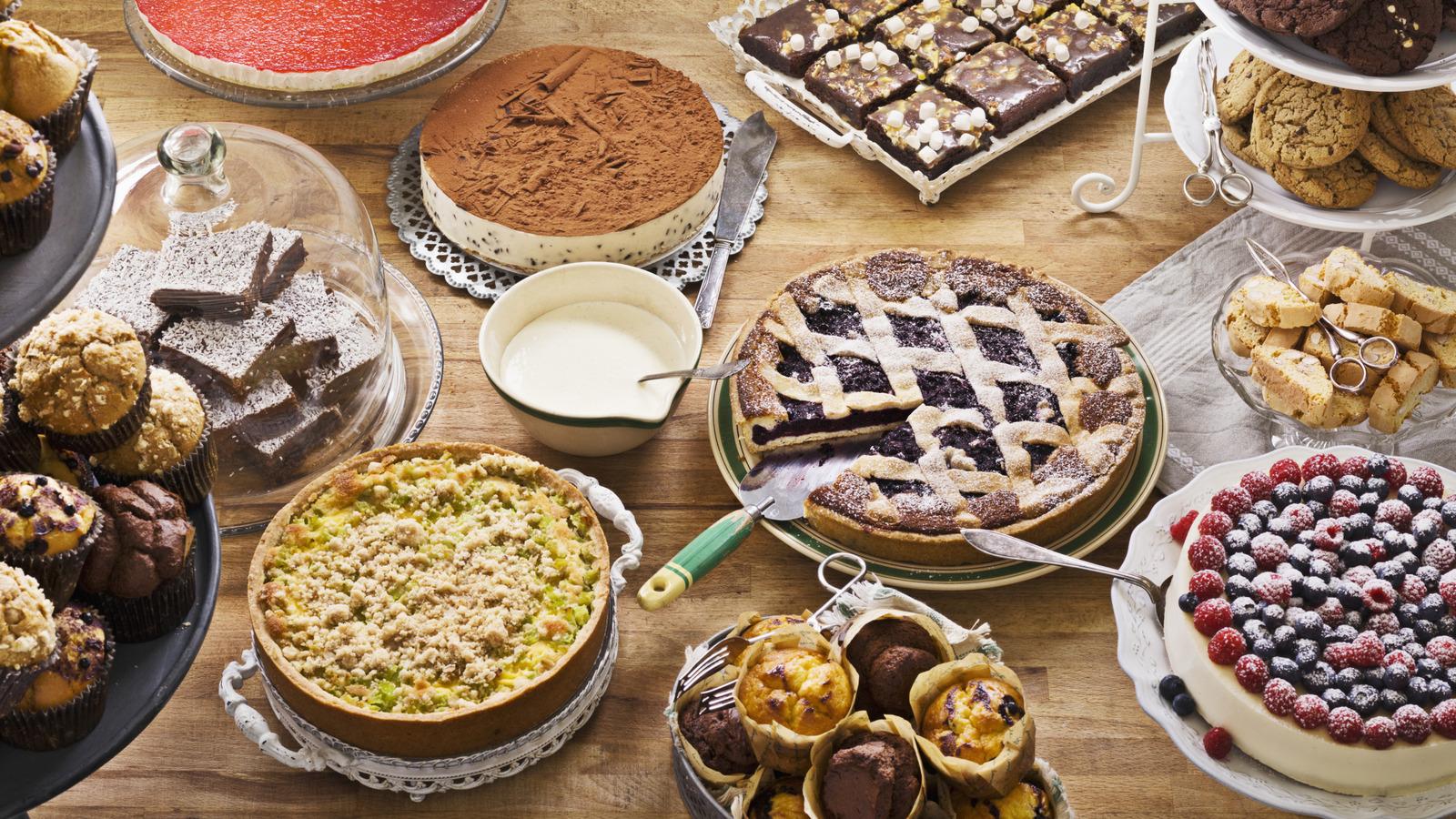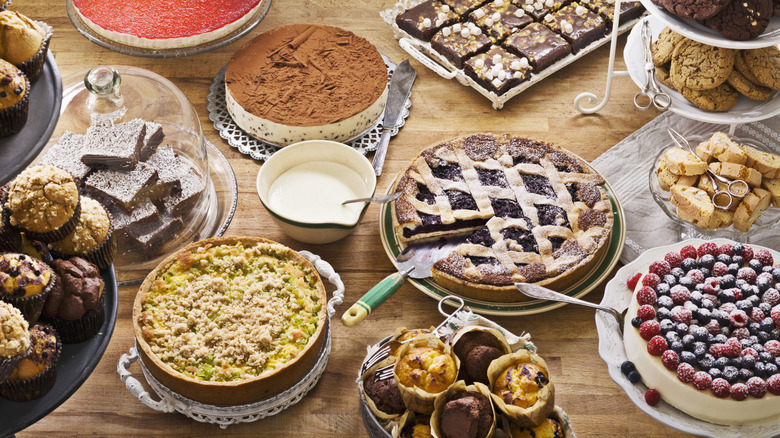
Johner Images/Getty Images
Put some respect on grandma's name, because the pie Grammy has been making for decades wins out from the mass produced competition almost every time. Is Nana's pie better simply because of nostalgia and the love she folds into the center, or could it be because she knows that nothing beats a good vintage pie recipe? Whatever the reason, it hasn't stopped a lot of these once beloved pie flavors and styles from disappearing.
The art of the pie hasn't disappeared altogether, as the dessert is still very much a favorite of many. Certain pies, though, have seemed to fade into time. Some of these lost pies are recipes created out of need for a low cost meal in times of suffering while others may have been meals born from trends of the past. Usually, these pies, no matter if they were sweet or savory, were tasty enough and became staples within the families and regions they were baked.
With grocery prices steadily increasing, it may be time to bring back some of the struggle pies of our forefathers and mothers. Whether we're talking about Depression-era pies or forgotten regional desserts, here are some pies that were once widely eaten but are now nearly extinct.
Marlborough pie

Viktory Panchenko/Shutterstock
Apple pie is one of the most popular pie flavors, and it's a classic stand-by. There have been many variations of the staple pie flavor over the decades. Some of these apple pie siblings have stuck around while others have all but tapered out of existence. Marlborough pie is one apple-filled pie that has been left behind in time.
While plain apple pie is essentially filled with baked apple slices, Marlborough pie has an apple custard filling. Creating this custard is a bit of extra work with more ingredients than just your typical apple pie, including lemon and sherry. The extra effort can be well worth it, with the result being a smooth, sweet and tangy dessert with the single crust adding a welcomed chew of texture.
Marlborough pie can be traced back to New England, where it was one of the best Thanksgiving pies you've never heard of. In modern times it has been replaced with traditional apple pie, which may be due to the abundance of apples. We no longer need to stretch common ingredients when they are relatively affordable and available in an accessible store. Still, the nearly lost pie could make for an interesting comeback when placed on your next Thanksgiving table.
Traditional mincemeat pie

Foodgraphy39/Shutterstock
Once upon a time, mincemeat pie was true to its name. It was made with cheaper cuts of meat, like cow tongue. Now, those few who do make mincemeat pies don't typically use meat at all. Instead, mincemeat is actually a mixture of dried fruit, nuts, and spices, and the combination is essentially the filling of the pie. The mixture does sometimes look like meat is involved somehow in the pie, but it's much more sweet than savory.
This pie as it's made today is typically only prepared and eaten in England, with the majority of Americans having never tried misnomered pie. Mincemeat pies are popular in Europe around the holiday season. As for the real traditional mincemeat pies, they've been around longer than you may think. People of the ancient world would have enjoyed mincemeat pies with actual meat incorporated into the fruit filling. Picture these pies in Ancient Rome and Egypt, whose people may have eaten the pies during an early version of Christmas.
These days, suet will occasionally be on the mincemeat pie ingredient list, paying homage to its omnivorous origins. Suet is a lard-like substance that is taken from the fatty parts of cows and sheep. Suet adds quite a lot of flavor to the pie, as well as texture. If this incorporation is anything to go off of, the ancient mincemeat pies were probably not half bad.
Onion pie
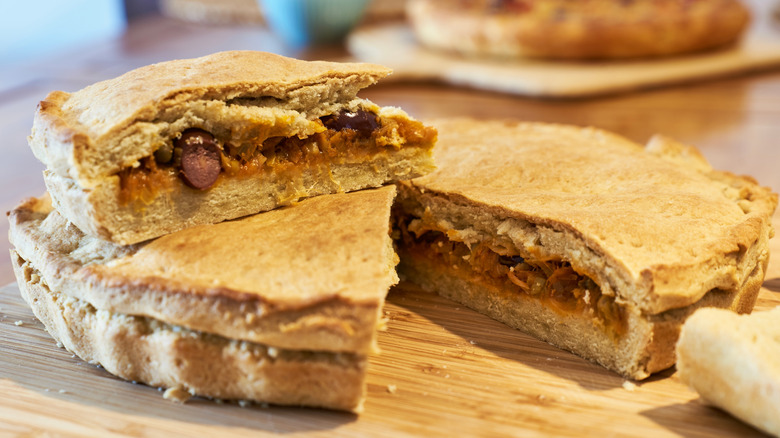
Roberto Rizzi/Shutterstock
Chicken pot pie has stood the test of time, but it isn't the only savory pie to feed our ancestors. Savory pies were ideal meals to make limited resources go further and feed more bellies. Onion pie in particular is genius, because you can essentially eat a single onion over and over again. Onions can be perpetual, meaning that you can eat almost the entire onion and still use the base to grow a new onion without much effort. This, and the fact that a pie is a great way to feed a large family, makes an onion pie ideal for hard times.
Onion pie utilizes other affordable and readily available ingredients, like potatoes, apples, and eggs. This may sound like we're working up to explain a quiche dish, but the eggs found in this pie are boiled and sliced before layered among the other sliced ingredients. With the addition of a double crust, the onion pie uses butter and spices to enhance flavor.
While a simple dish, not many people make or eat this savory pie these days. Onion pie was popular back in the 18th and 19th centuries, being found in cookbooks geared toward lower class and poverty stricken populations.
Butterscotch pie
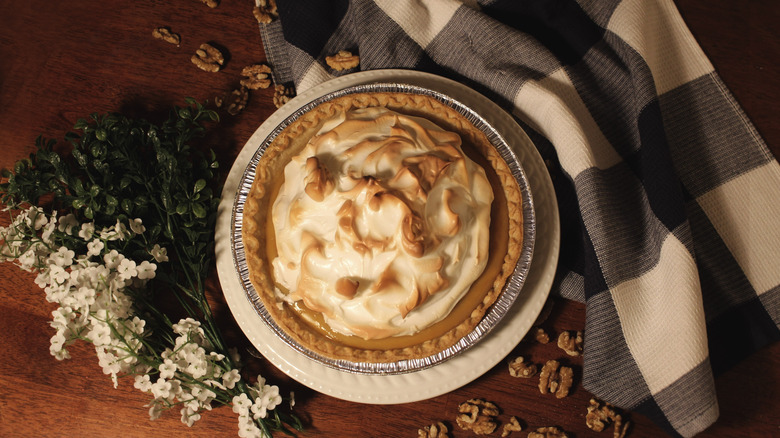
RCross/Shutterstock
Butterscotch is a classic grandma flavor, so it's no surprise that a pie of the same flavor made this list. To break this pie down, we have to know what, exactly, butterscotch is. Though on the surface it appears the same as toffee or caramel, butterscotch and caramel have very important differences, as does toffee. They all have similar ingredients and processes. The main takeaway is that butterscotch is made with brown sugar, has a prominent buttery taste and texture, and does not take long to make. As a pie, it's said the butterscotch variety was born in Indianapolis in the early 1900s.
Butterscotch pie consists of a single crust base filled halfway with a layer of butterscotch custard. The second half of the rich pie is a nicely whipped meringue. This gives the pie the look of a baked Alaska, sans fire. The crust and two layers of this pie are prepared separately, and once together the pie only needs a slight baking to toast the meringue.
From the mid 1800s to the mid 1900s, butterscotch was all the rage. It gained popularity first in Europe, and then in the United States with its popularity peaking in the early to mid 20th century. Its brother caramel, which is made with white sugar, is modernly much more popular as a dessert flavor and compliment. Caramel and other now popular flavors have all but pushed butterscotch into extinction.
Possum pie
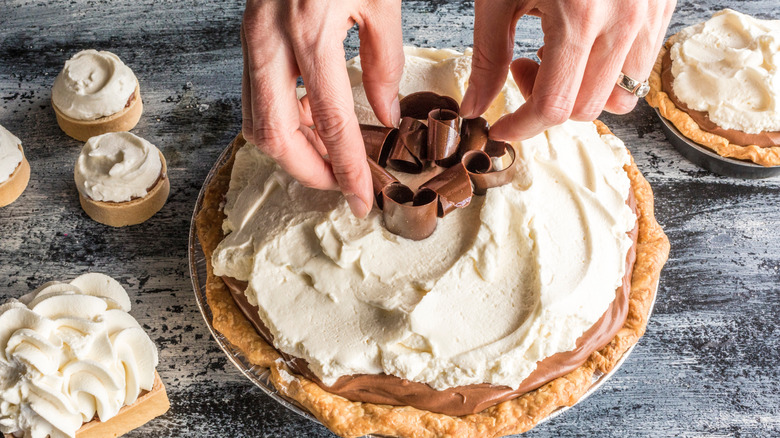
Scott Erb/Shutterstock
Though it sounds like something the deep South would come up with, the possum pie actually originated in Arkansas. Don't worry, this is another misnomer pie –– there's absolutely no possum in it. It's referred to as possum pie because it has a chocolate sleeper layer that goes under the radar until you cut into the pie. Though you've likely never heard of this pie, possum pie's popularity was in the 1970s and '80s, and we think it is due for a resurgence.
Another interesting characteristic of this pie is its crust. Instead of a typical pastry or graham cracker crust, possum pie has a pecan shortbread crust. The proof is in the pudding when it comes to possum pie, and the pudding is in the middle. Atop the pecan crust is two layers of whipped cream cheese separated by a homemade chocolate pudding center. Instead of baking, this pie is completed by popping it in the fridge for a while to chill before enjoying.
The possum pie, at first glance, is pretty unique. However, it's just a clever hybrid pie that has taken three or four ideas and mashed them together. You could call it a layered chocolate pecan cream pie, but there's a specific order and layout to a possum pie that makes the pie stand alone.
Funeral pie
Funeral pie isn't a very appetizing name, and maybe that is why it has gone out of style. Whatever the reason, though, funeral pie was a popular dish in areas of Pennsylvania that was often brought to funerals. In fact, this raisin pie was almost synonymous with funerals and wakes in the Mennonite community throughout the 1900s.
These pies being commonplace at funerals is what inspired the name, but the pie itself looks like something you'd find on a dinner table in a horror film. It's black in color and looks like either graveyard dirt or a pie full of flies. In reality, though, the pie is a simple custard in a crust with raisins. This pie can be made to look more appetizing by adding a whipped cream topping or adding a lattice crust on top.
These pies may still be commonplace in the Mennonite communities, but the majority of the population likely has never heard or seen one of these pies. The tradition of bringing food or dessert to grieving families is widespread, but this pie won't be seen at the majority of wakes. Outside of funerals, the closest thing to this pie is a simple raisin pie, but this is sometimes missing the custard texture of funeral pie.
Poor man's pie
As its name suggests, poor man's pie was created out of necessity and scarcity. People have to eat, and when there's not much around, the hardy make due. This pie has very few, basic ingredients, and there is essentially nothing in the pie itself. Poor man's pie has gone by many names with a few slight variations, because people in all different regions and countries have had to get by with below the bare minimum. Water pie is a relatively well-known rendition of this bare bones pie, as well as hard time's pie, and sugar pie.
A simple single crust is laid out in the pan, and the crust is the most complex part of the pie. Once you have your crust, bare ingredients are poured into the pastry. Some recipes call for cream, and others simply water. Whatever you happen to have on hand would be best for this pie, as to stay true to its intention. The other meager ingredients are typically a bit of sugar, flour, butter, and nutmeg if you can afford it. If using cream the ingredients get mixed before adding to the awaiting crust, and if they're water they get added separately and gently swirled together in the pie crust itself.
Once baked, the result is a delicate custard-like pie. While holding nearly no nutritional value whatsoever, this no frills pie offers a satisfying treat with using very few resources. This pie and variations like vinegar pie should make a comeback amid rising prices.
Kool-Aid pie
Kool-Aid pie may just be the sweetest way to eat your drink. If you were raised with summers of alternating colored pitchers of Kool-Aid, then there's probably half a chance this pie graced your cookouts, get-togethers, or dinner table at some point.
Relative to a lot of the other pies on this list, this refreshing sugar bomb of a pie seems less time worn. Sorry to be the one to break it to you, but anything prior to 2000 is now considered "vintage." This means that the trendy Kool-Aid pie your mom broke out for you to enjoy mid-summertime is, in fact, vintage — and so are you. Like a lot of things that have gone out of style, Kool-Aid pies are mostly made in modern times as a novelty. It's nostalgic for a time when Kool Aid was THE summertime companion, and the chilled pie is refreshing on a hot day.
Though Kool-Aid is still a relatively popular drink, the market is now flooded with kid-centric drink choices. This is likely why Kool-Aid pies have seemed to see a massive dip, and all but disappeared with our childhood. As those former Kool-Aid summer kids grow and have children of their own, this nostalgic dessert might make a bit of a comeback. It's perfect for kids, both because they love Kool-Aid and because it can be made with any flavored packet, the change in color being a point of interest for kiddos.
Mock Apple Pie
This pie comes with a dash of psychological warfare, because it both looks and tastes like apple pie, but there actually are no apples in it. Essentially, mock apple pie fools you into thinking it is apple pie. The apples typically found in traditional apple pie are replaced here with either crackers or breadcrumbs! Everything else about the two doppelganger pies is the same, it's prepared the same and contains all other ingredients. Mock apple pie simply deceives the brain into supplying that apple flavor on its own.
This deception is achieved because the two pies appear nearly identical and have a very similar smell. The traditional pie is so popular that the eater is likely familiar with the taste, and their brain makes the connection between the two. Sadly, we don't see pies playing head games like this anymore. This is a shame, because mock apple pie would be a no-brainer if you don't have apples on hand and want to avoid heading out to the store.
Originally, this pie was developed due to a lack of apples and surplus of Ritz crackers, so we have our poor ancestors to thank once more for a stellar pie recipe. The goodness of apple pie without the apples seems like a great way to save a bit of money while pranking your family at your next Thanksgiving dinner.
Shaker lemon pie
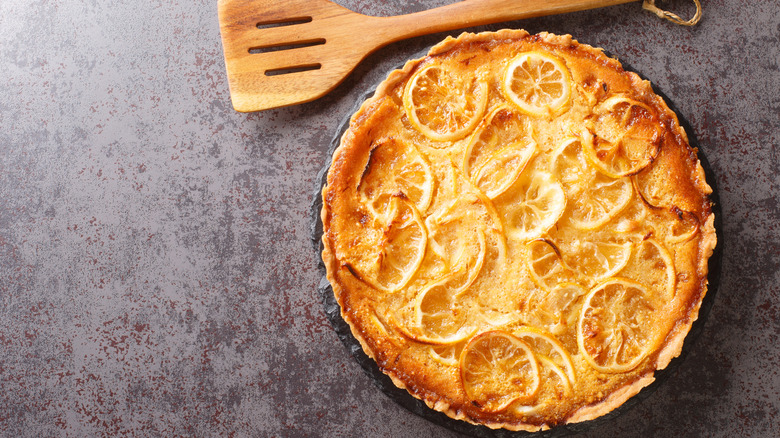
Alleko/Getty Images
Lemon pie is a relatively common pie flavor, and it's done in a number of different ways. Lemon meringue and lemon custard pies are two of the most popular renditions, but there is one lemon pie that modernly flies under the radar and it deserves its former popularity. Shaker lemon pie seems to be something that was only ever popular around Ohio, one of the places the Shakers migrated to from Europe. It makes sense why this pie isn't very popular these days, as the Shakers are nearly extinct themselves. Their cookbooks still survive, though, and their dishes have the opportunity to live on as well. Shaker lemon pie is one that certainly should.
This lemon pie is a version of custard pie, with a key difference being the utilization of the majority of the lemons, not just a little of the juice. One great way to incorporate the rind of the lemon into the pie is to use zest and to candy them for placing on the top of the pie. Whether followed to the letter of an original shaker recipe or tweaking the recipe to make it your own, this lemon pie is not one that should be lost to time.
White potato pie
When you picture a white potato dish that is pie adjacent, you likely think of some kind of casserole or pot pie situation. Actually, what you'll end up with is something that looks just like sweet potato pie, but without that festive orange coloring and signature yam taste. Sweet potato pie is a pretty popular pie even now, but its pale brother has been all but forgotten in time.
White potato pie is basically sweet potato pie sub white potatoes in more than just looks, which isn't much of a surprise. They're prepared quite similarly, too. What is a surprise, though, is how sweet and non-sweet potato pie can be. With just a cup of sugar and some minimal other ingredients, mashed potatoes can be made into a rich dessert.
White potato pie goes back as far as the early English settlers, with historians placing the dessert on the table of George Washington himself. Origins seem to stick to the East Coast, where you still may be able to find this dessert in Amish communities and a household here and there. Considering how affordable white potatoes are, white potato pie should be more widespread than its more seasonal sweet potato sister.



